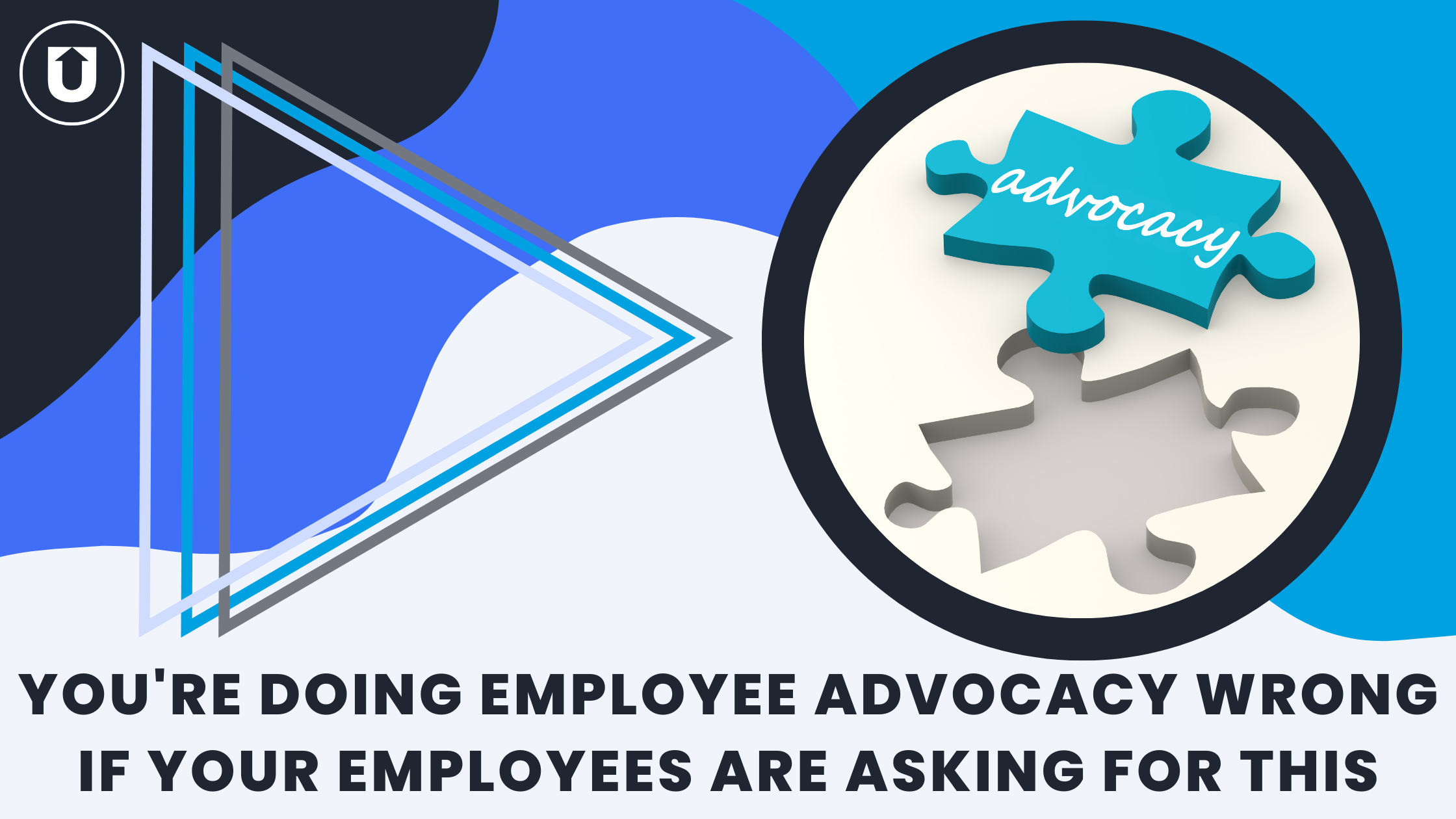You're Doing Employee Advocacy Wrong If Your Employees Are Asking For This

In this day and age of influencers and content creators, the value of quality engagement is skyrocketing.
People are developing their own audiences on LinkedIn, TikTok, Instagram, you name it, and monetizing their impressions, engagements, and comments.
Did anyone see social media heading in this direction? Maybe.
But now, there is a new conversation on LinkedIn about employers paying those employees who have built an engaged audience for activating that network to support their employer’s employee advocacy or social selling efforts instead of the seemingly "free" publicity and exposure they have been giving.
There are many different elements to this conversation, including who actually owns the content and digging into the value exchange occurring between employer and employee when these programs are done well vs. when done poorly.
If your employees feel they need to be compensated for participation in your employee advocacy program, this is the loudest symptom to indicate that this value exchange is imbalanced (whether real or perceived).
Who Owns The Content?
In social selling and employee advocacy efforts, a common goal is to utilize your employees' collective social connections to increase awareness about the company’s offerings and company culture.
But who actually owns the content that you're having your employees share?
If it's third-party content, the answer to that is easy: the original publisher.
And if you're creative team is creating company content and your team shares that, that's easy: It's the company's.
But there is a gray area here. Chances are, if you're employees are working to develop their thought leadership, they are adding their commentary and opinions or creating other posts to establish who they are in the industry.
Who owns that content?
See, at first, we would think it's the employee, but if you, as the employer, are helping to provide the content, the education, and the technologies for making their distribution of the content simple, then maybe it’s you.
You could say these offerings are similar to the benefits you provide to your employees as you support them in building their own personal brand (in addition to driving engagement for the company).
They keep growing their presence and following in a way that is not only valuable for their current position but the rest of their career, no matter where they work.
But on the other hand (cue Tevye talking to God in Fiddler on the Roof), the employee is using their own voice, their own social media profile, and their own social following to produce these results.
“Unless a social account is created and owned by the employer, it does not own and cannot mandate what employees post to their own, personal social networks,” Nola Morris, Chief Strategy Officer and Denim social, says.
Ok. So advocacy is a bit of a prickly pear. But before we go further down that rabbit hole, let’s see if social selling has the same challenge.
It is sales, after all. Revenue generation for the rep is good. Revenue generation for the company is good. Done deal?
Social Selling-Who Does It Actually Help?
When social selling is done in its proper form, sales reps or other employees use social media as a sales tool, the same way you would build a relationship with someone you know in your community.
Social media has just made it easier to connect and grow relationships with more people at once while also establishing yourself as an expert prospect can turn to.
So when a company provides the content and education to develop that online presence, who benefits more?
The sales rep or the company?
This could vary industry by industry, but when social selling efforts run smoothly and efficiently…both parties should benefit.
But suppose you require your employees to consistently share promotional content on their profiles without investing in education or providing the resources necessary to supplement these posts with other content that develops their personal brand, authenticity, and credibility.
In that case, that's not social selling or even employee advocacy.
That's just a sloppy distribution strategy that may provide a short-term pop but is rife with long-term consequences.
“If a company is considering a social posting requirement, it may want to step back and consider why they’re at that point to begin with.
Happy employees who want to share about their work on their personal social networks will. If they don’t, maybe they have chosen to keep their work out of their feeds, or they aren’t happy employees to begin with,” says Nola.
It’s similar to buying a distribution list and just constantly blasting promotional emails until your list dwindles to nothing but bouncebacks or your IP gets added to every blocklist.
But this is worse. In this case, your IP is your team’s personal social profile.
“Forced brand amplification through employees is not only disingenuous but is a culture-killer,” Nola says.
It’s Not All About Your Company
Picture this:
Your sales reps are saying they need content to share.
They don't care where it's coming from; they just need the content to be credible, help their prospects make better choices, and consider them as the prospect’s preferred resource.
In the early days of social media-based employee advocacy, a common response from the marketing department would be, “No guys, we are investing in this program for you to only share the content we create so that we can reach more people with our message.”
The result? Some team members did what was asked of them and consistently posted promotional content.
The marketing group saw an initial pop of impressions (and possibly engagement), but the number dropped drastically as time went on.
Others (perhaps rightfully) were unable to see the benefit in participation and opted out of the program either managing their social profiles independently (causing them to invest far more time and resources than they would if the company program were structured to properly support them) or to entirely neglect their social profiles - turning their backs on what could have become a stellar channel for building their sales pipeline.
It’s similar to the same famous scenario commonly described as a conversation between a CFO and CEO:

This same scenario can be applied today as marketing, sales, and human resources teams grapple with how to properly construct and message their employee advocacy or social selling efforts.
If the only content you're telling your team to share is your own, that's not a social selling strategy; that's just using your employees as nodes for content distribution.
And after supporting the implementation of hundreds of these efforts, it is clear that this approach will never be sustainable - no matter how many Amazon gift cards you wave in front of your team.
In these scenarios, we understand why there is a groundswell of discussion about employees being paid for content distribution on their personal channels.
There is little difference to paying social networks directly to share your company’s message with its audience.
The network has little control over the message and the message provides little value to the network for distributing it.
Therefore, to correct this imbalance, a fee must be paid. If the same approach is made in asking your team to share a message, the value exchange is no different.
“If the social audience of a particular employee is valuable to the employer, the employer should treat that employee in the same manner as they would a social media influencer,” Nola says.
“Social media influencers have curated an audience, or following, of people that are interested in the specific topics that person shares on social media.
If you want to reach the audience of a particular influencer, you pay the influencer to share your brand, company, or product on their channels to their audience.”
But, if you're implementing an effective social selling and employee advocacy strategy that is structured to support your employees as the primary customer of the investment, your team will naturally want to share the content you're providing because it is mutually beneficial.
Field marketing and sales reps want to share content that creates an engaging digital relationship with their networks.
- The content mix must be one that includes company authored, third-party, and employee-generated,
- The themes must include promotional, thought-leadership, lifestyle, and
- The technology for reviewing and distributing this content library must be one that is free of hassle, is present where they already spend their day, and can easily fit into their already busy routines.
Build Authenticity
What is the likelihood that your creative team will create great content about the areas your company has unique insights and expertise?
Through the roof.
What is the likelihood that these unique insights and expertise cover everything your prospects are interested in consuming and your team is interested in sharing?
It's very…very low.
No matter the size and resources available to your team, there are brilliant minds outside of your organization creating thoughtful content every day.
So when you're limiting your team to only content created by the same few (or let's face it, one-person marketing teams are a thing), you're limiting the effectiveness of your content distribution strategy.
But what if there was a way to transform your team into credible thought leaders and inspire them to naturally share about your brand?
Ultimately, their sentiments will be more genuine because they feel valued, invested, and supported.
So, in turn, they will do the same.
Branded vs. Personal
Don't evaluate your employee's social the same way as your branded social media.
Branded and personal social media roles are very different, with different purposes and different expectations from an audience member.
You, as a brand, are a creator. Your brand will develop its personality with the content your team creates, the content your brand shares (third-party or original), and how it engages with customers.
Your customers expect that your brand will be more infatuated with itself than others because, well, it’s your brand. A higher dose of promotional content is to be expected.
On the personal side, your employees often aren't "creators" per se, and those that are aren’t solely creating for your company brand.
If you're implementing a social selling strategy, you are most likely providing everything they share, from created to curated content.
But if your employees are naturally sharing the content you as the brand are providing i.e. selecting only the pieces that resonate with them and given the opportunity to add their own perspective, the audience member will see the person behind the profile as someone independent but connected to the company brand - building their own credibility and stimulating engagement amongst their audience.
“A healthy company culture will naturally show up on social if you give your employees a few posts to get them started. Don’t force it. And even better, compensate them if their audiences are valuable enough to you,” Nola says.
Final Thoughts On Paying Employees To Participate In Your Advocacy Program
Telling your team what to share is not an employee advocacy or social selling program - It's a distribution strategy with your team serving solely as a channel to their networks.
This doesn't mean that you can't help provide content for them to grow, learn, and hopefully share with their audiences, but the moment it's a requirement, you lose the authenticity that’s critical for sustaining a successful advocacy or selling program.
Instead, work on shaping a program that puts supporting your employees in becoming advocates for themselves first and foremost by helping develop their thought leadership.
In this approach, there won't be a discussion around additional compensation because your team is already directly reaping the benefits.
If your employees are thinking about asking for compensation for participating, you're doing it wrong.
If you'd like to learn more about social selling and how you can add curated content to your content distribution strategies, check out some of the articles!



